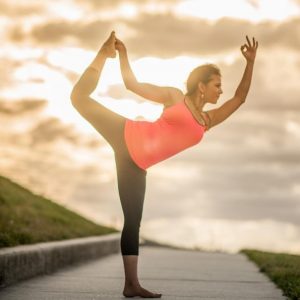Cow pose. Downward-facing dog. Pigeon pose. Mountain pose. Tree pose. Warrior.
If you’ve had any exposure to yoga, some of these phrases will sound familiar. The practice of yoga unifies the mind and body through coordinated breathing (pranayama), movement (asana) and meditation (dhyana), which all sound ideal and beneficial in the hectic rush of our day-to-day lives.

I’ve had an on-again, off-again relationship with yoga for many years. When I came to Johns Hopkins, I took some yoga classes with Pamela Jeter at the Cooley Center. Jeter has been a postdoctoral research fellow at the Wilmer Eye Institute where she examines the therapeutic benefits of yoga.
Earlier this year, Jeter and her colleagues published a paper to support a beneficial role of a modified yoga sequence called ashtanga based yoga therapy (AYT) in optimizing postural stability. The study was conducted with a vision-impaired population who either participated in an eight-week AYT program or were in a control group who did not.
The study included several measures of posture and balance. One, for example, was a modified Clinical Test of Sensory Interaction in Balance that tests a person’s balance under a variety of conditions (e.g., firm versus unstable surface, eyes closed versus open, etc.) to infer the source of instability. Though the groups had similar baseline measurements, the AYT group showed significantly improved measures of posture and balance compared to the control group. The authors hypothesize that these findings represent the benefits of AYT and they believe the program works by contributing to the development of the remaining somatosensory and vestibular responses. From a research perspective, these data will guide future studies to develop ways to reduce balance related problems and improve postural stability.
Jeter believes in the importance of yoga therapy as an adjunct to standard care in many clinical populations. “The field of yoga research in clinical populations is growing and we are seeing more and more therapeutic applications of yoga in hospital settings.”
But what about the benefits of yoga in our daily lives, outside the clinical setting? As a yoga researcher, yoga student and yoga teacher, Jeter believes in “the benefits of yoga for personal growth and for overall wellness.”
Nina Hosmane, a Ph.D. candidate in the Cellular and Molecular Medicine program, shares Jeter’s optimism about yoga. In her opinion, “[yoga] makes grad school much more manageable.” She also notes the benefits of yoga as a form of meditation.
To share her positive experiences with yoga, Hosmane offers free, one-hour yoga classes on Sundays at 4:30 p.m. at the Cooley Center on the Johns Hopkins medical campus. Hosmane starts her classes by encouraging participants to set an intention — perhaps to get through the class, let a frustration go or attain a physical goal, such as flexibility. She also likes to incorporate upbeat music and a challenging pose or two to keep things interesting.
Whether you have some experience with yoga or have never tried it, I encourage you to attend. These classes are open to all levels of yoga experience.
I saw a write up about a free yoga class @ the Cooley Center on Sundays at 4:30 pm
Q 1 - Is this open to JHH employees?
Q 2 - Is there a registration process?
Q 3 - Will it be a problem if I can only make 2 sessions /month?
Thank you for your questions, Maureen Gatto.
There is no registration for the yoga classes but because it's inside the Cooley Center, if you're not a member, you may need to contact them about options http://www.jhucooleycenter.com.
What type of stretches would you recommend doing?
-Cody
Comments are closed.